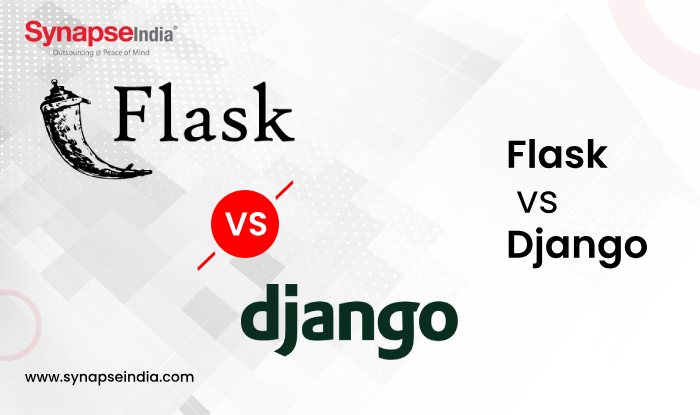 28 Mar 2024
28 Mar 2024“Flask and Django are Python web frameworks. Flask\'s lightweight approach suits small to medium projects and rapid prototyping. Django\'s comprehensive features, like its ORM and admin interface cater to large-scale complex web applications.”

Python frameworks are essential tools for developers seeking to build robust web applications quickly and efficiently. Among the most popular Python frameworks are Flask and Django, each offering unique advantages and catering to different development needs. Flask, known as a microframework, provides developers with the essentials for building web applications without the unnecessary bells and whistles.
On the other hand, Django is a full-stack web framework that comes equipped with a wide range of built-in features and tools, making it suitable for large-scale, complex applications. While Django may have a steeper learning curve compared to Flask, its comprehensive documentation and established community make it an excellent choice for developers seeking stability and scalability in their projects. In this blog, we will study a detailed comparison of Flask vs Django, which will help you understand which is the best Python Framework will be your best option.

Flask is a lightweight and flexible micro-framework for building web applications in Python. It was developed by Armin Ronacher and first released in 2010. Flask is known for its simplicity, minimalism, and ease of use, making it an ideal choice for developers who prefer to have more control over their project's structure and components.
Flask is designed to be lightweight, meaning it has minimal dependencies and provides only the essential features needed for web development. This makes it fast and efficient, particularly for small to medium-sized projects.
Flask follows a "micro" framework approach, which means it provides a basic structure and lets developers add or remove components based on their specific requirements. This flexibility allows developers to tailor their applications to meet their unique needs.
Flask has a minimalistic design philosophy, focusing on simplicity and elegance. It provides a simple and intuitive API that makes it easy to get started with web development in the best Python Framework.
Flask supports extensions, which are third-party packages that add additional functionality to the framework.
Flask comes with a built-in development server, making it easy to run and test applications locally without the need for additional setup. This built-in server is convenient for rapid prototyping and debugging during the development process.
Flask's combination of simplicity, flexibility, and extensibility makes it a popular choice for web developers who value control, customization, and efficiency in their projects.
Django is a high-level web framework for building web applications in Python. It was created by Adrian Holovaty and Simon Willison and first released in 2005. Django follows the "batteries-included" philosophy, providing a comprehensive set of features and tools for web development out of the box.
Django is a full-stack framework, meaning it provides everything developers need to build complete web applications, including an ORM (Object-Relational Mapping) for database interaction, a built-in admin interface, URL routing, form handling, template rendering, and more.
Django follows the "don't repeat yourself" (DRY) principle and emphasizes convention over configuration.
Django includes a powerful ORM that abstracts away the details of database interaction, allowing developers to work with database models using Python classes.
Django comes with a built-in admin interface that allows developers to quickly create and manage database records through a web-based interface.
Django provides a powerful URL routing mechanism that allows developers to define URL patterns and map them to view functions or class-based views.
Django's comprehensive feature set, built-in security, and scalability make it a popular choice for building robust and secure web applications in Python. Its adherence to best practices and conventions simplifies the development process and allows developers to focus on building great applications.

Being the most prominent frameworks, both Flask vs Django performance stand as a prominent choice for developers. Here is a detailed comparison between the two major frameworks.
| Feature | Flask | Django |
|---|---|---|
| Architecture | Microframework for web development | Full-stack web framework |
| Learning Curve | Easier for beginners, less boilerplate code | Steeper learning curve due to built-in features and conventions |
| Scalability | Lightweight and flexible, suitable for small to medium-sized applications | Robust and scalable, suitable for large-scale applications |
| Database Support | Supports various databases through extensions | Built-in support for ORM with Django ORM supports multiple databases out-of-the-box |
| Templating | Jinja2 template engine | Django's built-in template engine |
| Admin Interface | No built-in admin interface, but Flask-Admin can be used as an extension | Robust built-in admin interface for managing application data and users |
| Routing | Manual URL routing using decorators | Automatic URL routing based on URL patterns |
| ORM | Optional support for ORM with libraries like SQLAlchemy | Built-in ORM (Django ORM) with support for defining database models and querying databases |
| Security | Provides basic security features, requires additional configuration for advanced security measures | Built-in security features including protection against common web vulnerabilities |
| Community | Active community, extensive documentation | Large and established community, comprehensive documentation, and resources available |
The differences between Flask and Django are based on the particular needs and preferences of your project. Both Flask and Django are strong Python web frameworks, each with advantages and disadvantages, so before choosing one, think about the requirements of your project. Flask is well-known for being straightforward and adaptable, which makes it perfect for small- to medium-sized projects or ones that call for a lot of customization. Django, on the other hand, is a full-stack framework that takes a stronger stance on web development.
Django is a superior choice for projects that require a complete set of features and conventions right out of the box, whereas Flask is excellent for those that demand flexibility and customization. The final "winner" will rely on the team's experience, the development strategy, and the particular requirements of your project.
All things considered, Flask and Django both provide strong best Python Framework web development platforms that can accommodate a wide range of project needs and developer preferences. Python frameworks like Flask and Django offer the resources and assistance required to realize your ideas, whether you're creating a basic prototype or a complex online application.


